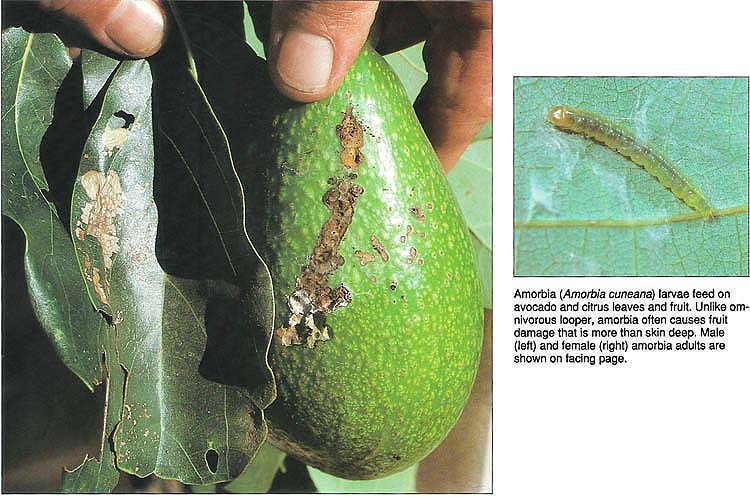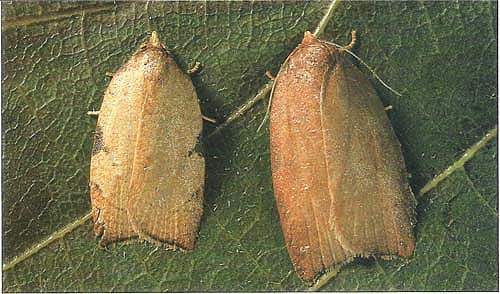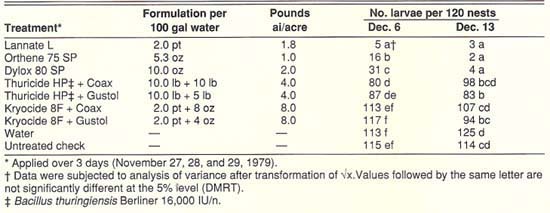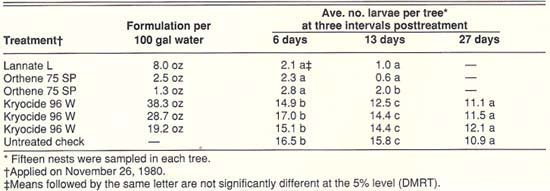All Issues
Chemical control of amorbia, an insect pest of avocado and citrus
Publication Information
California Agriculture 44(6):10-11.
Published November 01, 1990
PDF | Citation | Permissions
Abstract
Several insecticides were evaluated for control of amorbia, a “worm” pest of avocados and citrus in California. Lannate was the only effective chemical that is currently registered for bearing avocados in California.
Full text
Amorbia (Amorbia cuneana) larvae feed on avocado and citrus leaves and fruit. Unlike omnivorous looper, amorbia often causes fruit damage that is more than skin deep. Male (left) and female (right) amorbia adults are shown on facing page.
Amorbia cuneana (Walsingham), known to most growers as amorbia, is a sporadic “worm” pest of avocados in California. Recently it has also become an important pest of citrus in the San Joaquin Valley. It feeds on the leaves and fruit of both food crops, causing economic losses to growers.
University of California researchers are developing a pest management program for avocados covering amorbia as well as the omnivorous looper, Sabulodes aegrotata (Guenee); the greenhouse thrips, Heliothrips haemorrhoidalis (Bouche); the avocado brown mite, Oligonychus punicae (Hirst); and the six-spotted mite, Eotetranychus sexmaculatus (Riley). The research emphasizes the development of control measures that do the least harm to beneficial organisms.
An important control measure for the pest management program has been the repeated release of the wasp Trichogramma platneri Nagarkatti, an egg parasite. Experiments have demonstrated that T. platneri is effective as a parasite of both amorbia and the omnivorous looper. The parasite is now commercially available (California Agriculture November-December 1985).
Three synthetic sex pheromones are also commercially available for monitoring amorbia and omnivorous looper flight activity. Timing is critical — T. platneri wasps must be released when target moths are flying, mating, and laying eggs. The demand for T. platneri can often exceed supply during peak flight periods, limiting the usefulness of this control method. To provide growers with a chemical supplement to biological control, we evaluated insecticides in three field trials for control of amorbia larvae. During all three trials, larvae were in mid- to late-instar stages of development.
Insecticide trials
For two of the trials, we used ground-based application equipment, and for the other we used a helicopter. In the two ground trials, insecticides were applied by handgun from a standard orchard type hydraulic spray rig.
The insecticides tested in the first ground trial were Kryocide (cryolite), Thuricide (Bacillus thuringiensis Berliner), Lannate (methomyl), Orthene (acephate), and Dylox (trichlorfon). The first two insecticides are stomach poisons and selectively kill plant-feeding insects. Consequently, they have little direct effect on beneficial insects and mites. Both chemicals were applied with feeding stimulants (Coax or Gustol). The other three insecticides are broad-spectrum insecticides. Lannate is known for its effectivness on many lepidopterous pests and for its rapid degradation. Orthene is toxic to a wide variety of pests, and is less toxic than Lannate to humans. Dylox is considered to be somewhat selective.
Treatments were applied to trees spaced at 20′ × 20′ intervals in a 5-year-old Ventura County Bacon avocado grove. The randomized complete block experimental design included six replicates consisting of two trees each. Replicates were separated from one another by an untreated buffer tree. Trees were sprayed to runoff (ca. 4 gal. per tree, or 400 gpa) at 400 psi. Chemical application rates are listed in table 1.
We evaluated the treatments 7 days and 14 days after application by examining 10 nests of amorbia larvae per tree. At 7 days, Lannate performed the best, followed in order by Orthene and Dylox (table 1). When applied with either of the feeding stimulants, Thuricide provided only marginal control. Kryocide was ineffective with either feeding stimulant.
Lannate, Orthene, and Dylox remained effective 14 days posttreatment, and did not differ significantly from each other in their effectiveness. Thuricide was only marginally effective with either feeding stimulant, and Kryocide was ineffective. No phytotoxicity to leaves or fruit was noted at any time during the study.
Lannate, two rates of Orthene, and three rates of Kryocide were tested in the second ground trial. These insecticides were tested on 6-year-old Riverside County Zutano avocado trees spaced at 15′ × 20′ intervals. The modes of application were similar to those used in the first trial. The randomized complete block design comprised eight single-tree replicates. Two untreated buffer trees separated each replicate.
Again, the trees were sprayed to runoff (ca. 6 gal. per tree, or 870 gpa) at 400 psi. Chemicals, application rates, and results are shown in table 2.
TABLE 1. Ground applications of insecticides for control of A. cuneana in Ventura County, November 1979
TABLE 2. Ground applications of insecticides for control of A. cuneana in Riverside County, November 1980
We evaluated the treatments by examining 15 larval nests per tree. After 6 days and again after 13 days, Lannate and both rates of Orthene provided very good control (table 2). Kryocide was ineffective at all three rates. Kryocide-treated trees were sampled after 27 days, and again those treatments proved ineffective. No phytotoxicity was apparent.
The mountainous terrain common to many avocado groves often makes helicopter application the most practical means of insecticide treatment. In December 1980, our project applied Lannate 90 SP, Orthene 75 SP, and Kryocide 96 W by helicopter to different trees in the same grove used for the second ground trial. The insecticides were applied in 20 gallons of water per acre at 0.5, 1.0, and 12.0 lbs active ingredient (ai) per acre, respectively, to a single row of trees per treatment (ca. 0.5 acres). Test rows were separated by at least six untreated buffer rows.
Again, we evaluated the treatments by checking for live larvae in 15 randomly selected nests per tree. All treatments were ineffective 7 and 14 days posttreatment. We observed no phytotoxicity.
Conclusions
The preponderance of beneficial insects and mites in avocado groves makes the use of a selective insecticide highly desirable for amorbia control. However, in our trials neither Thuricide nor Kryocide gave adequate control of amorbia. The field trials reported here were directed against mid- to late-instars. Field observations indicate that Thuricide provides somewhat better control of younger larvae.
Lannate and Orthene were the most effective insecticides applied by ground equipment. Lannate is now fully registered for use on bearing avocados in California. Orthene is not. No insecticide was effective when applied by helicopter, probably because of inadequate spray coverage.
Amorbia infestations are often confined to localized areas within an avocado grove, so spot treatments of Lannate applied with ground equipment may provide effective control. Insecticides should only be applied when other means of control have failed. An effective, selective insecticide for amorbia is still needed. Newer strains of Bacillus thuringiensis are now commercially available, but they have not been tested adequately in the field.








